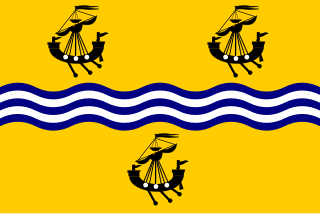
The Outer Hebrides or Western Isles, sometimes known as the Long Isle or Long Island, is an island chain off the west coast of mainland Scotland. The islands are geographically coextensive with Comhairle nan Eilean Siar, one of the 32 unitary council areas of Scotland. They form part of the archipelago of the Hebrides, separated from the Scottish mainland and from the Inner Hebrides by the waters of the Minch, the Little Minch, and the Sea of the Hebrides.
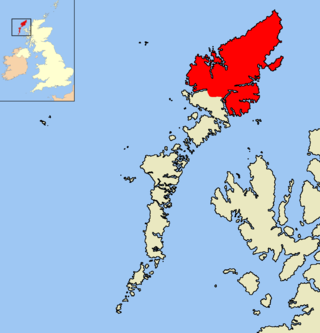
The Isle of Lewis or simply Lewis is the northern part of Lewis and Harris, the largest island of the Western Isles or Outer Hebrides archipelago in Scotland. The two parts are frequently referred to as if they were separate islands. The total area of Lewis is 683 square miles (1,770 km2).

Stornoway is the main town, and by far the largest town, of the Outer Hebrides, or Western Isles, and the capital of Lewis and Harris in Scotland.

Kyle of Lochalsh is a village in the historic county of Ross & Cromarty on the northwest coast of Scotland, located around 55 miles (90 km) west-southwest of Inverness. It is located on the Lochalsh peninsula, at the entrance to Loch Alsh, opposite the village of Kyleakin on the Isle of Skye. A ferry used to connect the two villages until it was replaced by the Skye Bridge, about a mile (2 km) to the west, in 1995.

Point, also known as the Eye Peninsula, is a peninsula some 11 km long in the Outer Hebrides, Scotland. The majority of Point is connected to the rest of the Isle of Lewis by a narrow isthmus, one mile in length and at one point barely 100 metres wide. The peninsula is just 6 km east of the regional capital of Stornoway, however the district of Point actually starts at the Parkend estate on Stornoway's outskirts. Point is home to around 2,600 people and is one of the few districts of the Western Isles where the population is increasing. There are about 17 villages and hamlets in Point: Melbost (Mealabost), Branahuie, Aignish (Aiginis), Knock, Swordale (Suardail), Garrabost, Lower Bayble, Eagleton, Upper Bayble, Shulishader, Sheshader (Seisiader), Flesherin (Fleisirin), Cnoc Amhlaigh, Portnaguran, Aird, Broker (Brocair), and Portvoller.

Ness is the northernmost part of the Isle of Lewis, a community consisting of about 16 villages, including Lionel, Habost, Swainbost, Cross, North and South Dell, Cross Skigersta, Skigersta, Eorodale, Adabroc, Port of Ness, Knockaird, Fivepenny and Eoropie. It was the most north-westerly community in the European Union, when the United Kingdom was a member. Its most northerly point is the Butt of Lewis. The name Ness derives from the old Norse for headland and many of the other place names in the area also have a Norse origin.

Aignish is located northwest of Knock and east of Stornoway on the east coast of the Isle of Lewis, in the Outer Hebrides, Scotland. The township is at the island side of the isthmus connecting to the Eye peninsula. Aignish is within the parish of Stornoway, and is situated on the A866 between Stornoway and Portnaguran.
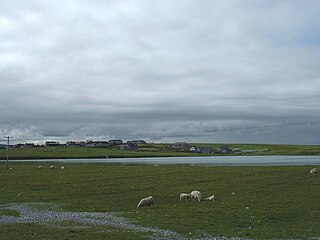
Melbost is a traditionally Gaelic-speaking village in Point on the east coast of the Isle of Lewis, in Scotland's north-west. It is largely a crofting township and is about 2+1⁄2 miles east of Stornoway at the head of an isthmus connecting with the Eye Peninsula. Melbost is technically in the district of Point; however, it is not located on the Eye Peninsula itself. The RAF Stornoway war memorial is located in the village.

Gress, a hamlet on the Isle of Lewis in Scotland, is adjacent to the larger village of Back. Gress is within the parish of Stornoway. Between 1919 and 1921, Gress – along with nearby Coll and Tong – was the scene of several land raids.
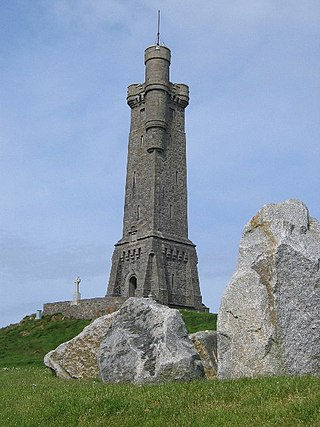
The Lewis War Memorial is a war memorial dedicated to the men from the Lewis area who lost their lives in World War I and those who survived the war only to drown while returning home during the 1919 sinking of HMY Iolaire. Completed in 1924, the memorial is situated at the highest point of the town of Stornoway.

The Hebrides were settled early on in the settlement of the British Isles, perhaps as early as the Mesolithic era, around 8500–8250 BC, after the climatic conditions improved enough to sustain human settlement. There are examples of structures possibly dating from up to 3000 BC, the finest example being the standing stones at Callanish, but some archaeologists date the site as Bronze Age. Little is known of the people who settled in the Hebrides but they were likely of the same Celtic stock that had settled in the rest of Scotland. Settlements at Northton, Harris, have both Beaker & Neolithic dwelling houses, the oldest in the Western Isles, attesting to the settlement.

Holm Village is a village in the Scottish Outer Hebrides, on the Isle of Lewis near Stornoway. The modern area of Holm can be split into two distinct areas - "Holm Village" and "Holm Road with Parkend". Holm is within the parish of Stornoway.

Parkend is a hamlet in the Sandwick region of the Isle of Lewis, although like Melbost, it is not a part of the Eye Peninsula. Many people erroneously believe it to be a suburb of Stornoway, on the island of Lewis and Harris in the Outer Hebrides of Scotland. Parkend is within the parish of Stornoway. Parkend is situated on the A866, and the adjoining Holm Road allows access to the nearby Holm Village. The Parkend Industrial Estate is adjacent to the small housing estate.

Borve is a village on the west side of the Isle of Lewis in Scotland, 17 miles from the island's only town, Stornoway.

Cross is a township on the Isle of Lewis in the community of Ness, in the Outer Hebrides, Scotland. Cross is within the parish of Barvas. Cross is also situated on the A857, between Stornoway and Port of Ness.

Swainbost is a village on the Isle of Lewis in the district of Ness, in the Outer Hebrides, Scotland. The name Swainbost meaning Sweins steading is of Viking derivation. The settlement is situated in the parish of Barvas. According to Ronald Black, Swainbost was re-settled during the Highland Clearances in 1842. The island's Anglo-Scottish landlord had expected the crofters evicted from Uig to emigrate and only reluctantly granted them land at Swainbost to avert the threat of violence.
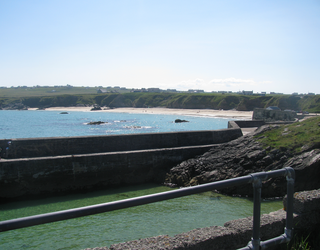
Port of Ness is a village on the Isle of Lewis in the community of Ness, in the Outer Hebrides, Scotland. Port of Ness is within the parish of Barvas. Port of Ness is situated at the end of the A857, which runs from Stornoway. In 2014, the Ness Fishery Memorial was erected to celebrate the fishing heritage in the area and to commemorate the 96 people who lost their lives in the industry between 1835 and 1900.

Lewis and Harris, or Lewis with Harris, is a single Scottish island in the Outer Hebrides, divided by mountains. It is the largest island in Scotland and the third largest in the British Isles, after Great Britain and the island of Ireland, with an area of 841 square miles (2,178 km2), which is approximately 1% of the area of Great Britain. The northern two-thirds is called [the Isle of] Lewis and the southern third [the Isle of] Harris; each is referred to as if it were a separate island and there are many cultural and linguistic differences between the two.
Events from the year 1919 in Scotland.





















